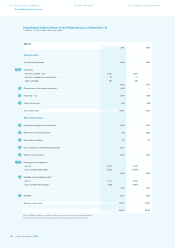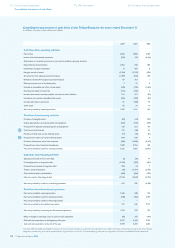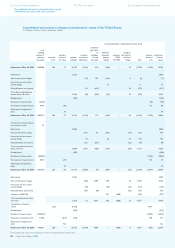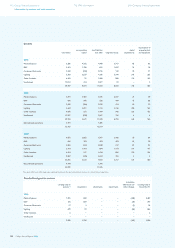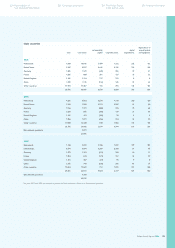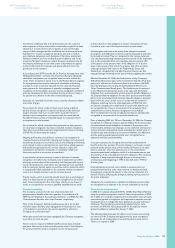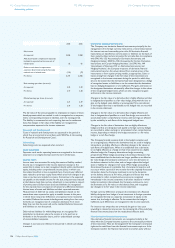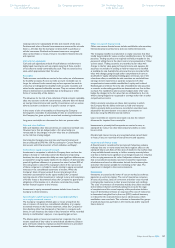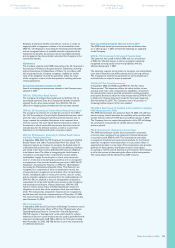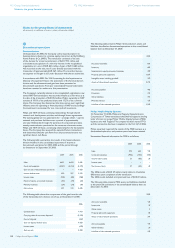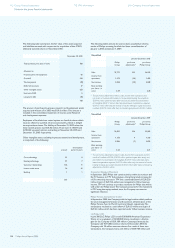Philips 2006 Annual Report Download - page 125
Download and view the complete annual report
Please find page 125 of the 2006 Philips annual report below. You can navigate through the pages in the report by either clicking on the pages listed below, or by using the keyword search tool below to find specific information within the annual report.
Philips Annual Report 2006 125
the delivery conditions, title and risk have passed to the customer
and acceptance of the product, when contractually required, has been
obtained, or, in cases where such acceptance is not contractually
required, when management has established that all aforementioned
conditions for revenue recognition have been met and no further
post-shipment obligations exist. Examples of the above-mentioned
delivery conditions are ‘Free on Board point of delivery’ and ‘Costs,
Insurance Paid point of delivery’, where the point of delivery may be
the shipping warehouse or any other point of destination as agreed
in the contract with the customer and where title and risk in the
goods pass to the customer.
In accordance with EITF Issue No. 00-21, ‘Revenue Arrangements with
Multiple Deliverables’, revenues of transactions that have separately
identifi able components are recognized based on their relative fair
values. These transactions mainly occur in the Medical Systems segment
for arrangements that require subsequent installation and training
activities in order to become operable for the customer. However,
since payment for the equipment is typically contingent upon the
completion of the installation process, revenue recognition is deferred
until the installation has been completed and the product is ready to
be used by the customer in the way contractually agreed.
Revenues are recorded net of sales taxes, customer discounts, rebates
and similar charges.
For products for which a right of return exists during a defi ned
period, revenue recognition is determined based on the historical
pattern of actual returns, or in cases where such information is
lacking, revenue recognition is postponed until the return period
has lapsed. Return policies are typically based on customary return
arrangements in local markets.
For products for which a residual value guarantee has been granted
or a buy-back arrangement has been concluded, revenue recognition
takes place in accordance with the requirements for lease accounting
of SFAS No.13, ‘Accounting for Leases’.
Shipping and handling costs billed to customers are recognized as
revenues. Expenses incurred for shipping and handling costs of internal
movements of goods are recorded as cost of sales. Shipping and handling
costs related to sales to third parties are reported as selling expenses
and disclosed separately. Service revenue related to repair and
maintenance activities for sold goods is recognized ratably over
the service period or as services are rendered.
A provision for product warranty is made at the time of revenue
recognition and refl ects the estimated costs of replacement and free-
of-charge services that will be incurred by the Company with respect
to the sold products. In cases where the warranty period is extended
and the customer has the option to purchase such an extension, which
is subsequently billed separately to the customer, revenue recognition
occurs on a straight-line basis over the contract period.
Royalty income, which is generally earned based upon a percentage of
sales or a fi xed amount per product sold, is recognized on an accrual
basis. Government grants, other than those relating to purchases of
assets, are recognized as income as qualifi ed expenditures are made.
Benefi t accounting
The Company accounts for the cost of pension plans and
postretirement benefi ts other than pensions in accordance with
SFAS No. 87, ‘Employers’ Accounting for Pensions’, and SFAS No. 106,
‘Postretirement Benefi ts other than Pensions’, respectively.
Most of the Company’s defi ned-benefi t pension plans are funded
with plan assets that have been segregated and restricted in a trust
or foundation to provide for the pension benefi ts to which the
Company has committed itself.
When plan assets have not been segregated, the Company recognizes
a provision for such amounts.
Pension costs in respect of defi ned-benefi t pension plans primarily
represent the increase in the actuarial present value of the obligation
for pension benefi ts based on employee service during the year
and the interest on this obligation in respect of employee service
in previous years, net of the expected return on plan assets.
Actuarial gains and losses arise mainly from changes in actuarial
assumptions and differences between actuarial assumptions and what
has actually occurred. They are recognized in the income statement,
over the expected average remaining service periods of the employees,
only to the extent that their net cumulative amount exceeds 10%
of the greater of the present value of the obligation or of the fair
value of plan assets at the end of the previous year (the corridor).
Unrecognized gains and losses in the Netherlands, France and
Thailand are recognized by a straight-line amortization over the
expected average remaining service period without applying the corridor.
Effective December 31, 2006, the funded status of the Company’s
defi ned-benefi t pension plans and postretirement benefi ts other than
pensions is refl ected on the balance sheet in accordance with SFAS
No. 158, ‘Employers Accounting for Defi ned Benefi t Pension and
Other Postretirement Benefi t plans’. The funded status is measured
as the difference between plan assets at fair value and the benefi t
obligation. For a defi ned-benefi t pension plan, the benefi t obligation is
the projected benefi t obligation; for any other postretirement benefi t
plan it is the accumulated postretirement benefi t obligation. Actuarial
gains and losses, prior service costs or credits and the transition
obligation remaining from the initial application of SFAS 106 that
are not yet recognized as components of net periodic benefi t cost
are recognized, net of tax, as a component of accumulated other
comprehensive income. Amounts recognized in accumulated
other comprehensive income are adjusted as they are subsequently
recognized as components of net periodic benefi t cost.
Prior to adopting SFAS No. 158 as of December 31, 2006, the Company
recognized an additional minimum pension liability. To the extent that
the accumulated benefi t obligation, calculated as the present value
of the benefi ts attributed to employee service rendered and based on
current and past compensation levels, exceeded the market value of
the plan assets and existing accrued pension liabilities, this difference
and the existing prepaid pension assets were recognized as an
additional minimum pension liability.
In certain countries, the Company also provides postretirement
benefi ts other than pensions. The cost relating to such plans consists
primarily of the present value of the benefi ts attributed on an equal
basis to each year of service, interest cost on the accumulated
postretirement benefi t obligation, which is a discounted amount, and
amortization of the unrecognized transition obligation. This transition
obligation is being amortized through charges to earnings over a
twenty-year period beginning in 1993 in the USA and in 1995 for
all other plans.
Unrecognized prior-service costs related to pension plans and
postretirement benefi ts other than pensions are being amortized
by assigning a proportional amount to the income statements of a
number of years, refl ecting the average remaining service period of
the active employees.
Obligations for contributions to defi ned-contribution pension plans
are recognized as an expense in the income statement as incurred.
Share-based compensation
In 2006, the Company adopted SFAS No. 123(R), ‘Share-Based Payment’,
using the modifi ed prospective method. Under the provisions of SFAS
No. 123(R), the Company recognizes the estimated fair value of equity
instruments granted to employees as compensation expense over the
vesting period on a straight-line basis, taking into account estimated
forfeitures. The Company had previously adopted the fair value
provisions of SFAS No. 123 prospectively for all employer awards
granted, modifi ed or settled after January 1, 2003.
The following table illustrates the effect on net income and earnings
per share as if the Company had applied the fair value recognition
provisions for all outstanding and unvested awards in each period.
There is no impact in 2006.
226 Corporate governance224 Reconciliation of
non-US GAAP information
234 The Philips Group
in the last ten years
236 Investor information



